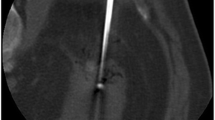Abstract
The purpose of this study was to compare our experience with ultrasound (US)-guided percutaneous radiofrequency thermal ablation (RFA) of renal tumors with results of CT-guided and MRI-guided series in the current literature. Of 90 consecutive renal tumors treated with RFA in 71 patients, 87 lesions were ablated under US guidance. We performed a retrospective analysis of clinical outcome and safety. Results were then compared to published case series where CT and MRI guidances were used exclusively. In our series we had a major complication rate of 4.6%, whereas in CT- and MRI-based series it was 0–12% (mean, 2.2%) and 0–8.3% (mean, 4.1%), respectively. During follow-up (1–68 months; mean, 24 months) technical effectiveness was 89.7%, while it was between 89.5% and 96% in CT-guided series and between 91.7% and 100% in MRI-guided series. The size of successfully treated lesions (28 mm) was lower than that of partially-ablated lesions (36 mm; p = 0.004) and only central lesion location proved to be a negative prognostic factor (p = 0.009); in CT-guided series, positive prognostic factors were exophytic growth and size ≤3 cm. “Tumor-specific” 2-year survival was 92% in our series, 90–96% in CT-guided series, and not reported in MRI-guided series. In conclusion, despite common beliefs, US guidance in RFA of renal tumors is not less favorable than other guidance techniques. Thus the interventional radiologist can choose his or her preferred technique taking into account personal experience and available equipment.




Similar content being viewed by others
References
Jemal A, Siegel R, Ward E et al (2006) Cancer statistics. CA Cancer 56:106
Jaison M, Sanders H (1998) Increased incidence of serendipitously discovered renal cell carcinoma. Urology 51:203–205
Duque JL, Loughlin KR, O’Leary MP et al (1998) Partial nephrectomy: alternative treatment for selected patients with renal cell carcinoma. Urology 58:584–590
Novick AC (2004) Laparoscopic and partial mephrectomy. Cancer Res 10:6322–6327
Clarck TWI, Malkowicz B, Stavropoulos SW et al (2006) Radiofrequency ablation of small renal cell carcinomas using multitined expandable electrodes: preliminary experience. J Vasc Interv Radiol 17:513–519
Hines-Peralta A, Goldberg SN (2004) Review of RFA for renal cell carcinoma. Clin Cancer Res 235:1065–1071
Cambio AJ, Evans CP (2006) Management approaches to small renal tumours. BJU Int 97:456–460
Boss A, Clasen S, Kuczyk M et al (2005) Magnetic resonance-guided percutaneous radiofrequency ablation of renal cell carcinomas. A pilot clinical study. Invest Radiol 40:583–590
Hoffmann RT, Jakobs TS, Trumm C et al (2008) RFA of renal cell carcinoma in a solitary kidney. Adbom Imaging 33(2):230–236
Park S, Cadeddu JA (2007) Outcomes of radiofrequency ablation for kidney cancer. Cancer Control 14(3):205–210
Zagoria RJ (2004) Imaging-guided radiofrequency ablation of renal masses. Radiographics 24:S59–S71
Zagoria RJ, Traver MA, Werle DM et al (2007) Oncologic efficacy of CT-guided percutaneous radiofrequency ablation of renal cell carcinomas. AJR 189:429–436
Sacks D, McClenny TE, Cardella JF et al (2003) Society of Interventional Radiology Clinical Practice Guidelines. J Vasc Interv Radiol 14:S199–S202
Gervais DA, McGovern FJ, Wood BJ et al (2000) Radiofrequency ablation of renal cell carcinoma: early clinical experience. Radiology 217:665–672
Salagierski M, Salagierski Salagierska-Barwinska A et al (2006) Percutaneous ultrasound-guided radiofrequency ablation for kidney tumors in patients with surgical risk. Int J Urol 13:1375–1379
Ahrar K, Matin S, Wood CG et al (2005) Percutaneous radiofrequency ablation of renal tumors: technique, complications, and outcomes. J Vasc Interv Radiol 16:679–688
Permpongkosol S, Link RE, Solomon SB et al (2006) Results of computerized tomography guided percutaneous ablation of renal masses with nondiagnostic pre-ablation pathological findings. J Urol 176:463–467
Arzola J, Baughman M, Hernandez J et al (2006) Computed tomography-guided, resistance-based, percutaneous radiofrequency ablation of renal malignancies under conscious sedation at 2 years of follow-up. Urology 68:983–987
Varkarakis IM, Allaf ME, Inagaki T et al (2005) Percutaneous radio frequency ablation of renal masses: results at 2 year mean followup. J Urol 174:456–460
Boss A, Clasen S, Kuczyc M et al (2005) Magnetic resonance-guided percutaneous radiofrequency ablation of renal cell carcinomas, a pilot clinical study. Invest Radiol 40:583–590
Lewin JS, Nour SG, Connel CF et al (2004) Phase II clinical trial of interactive MR imaging-guided interstitial radiofrequency thermal ablation of primary kidney tumors: initial experience. Radiology 232:835–845
Gervais DA, McGovern FJ, Arellano RS et al (2003) Renal cell carcinoma: clinical experience and technical success with radio-frequency ablation of 42 tumors. Radiology 226:417–424
Farrell MA, Charboneau WJ, DiMarco DS et al (2003) Imaging-guided radiofrequency ablation of solid renal tumours. AJR 180:1509–1513
Mayo-Smith WW, Dupuy DE, Parikh PM et al (2003) Imaging-guided percutaneous radiofrequency ablation of solid renal masses: techniques and outcomes of 38 treatment sessions in 32 consecutive patients. AJR 180:1503–1508
Breen DJ, Rutherford EE, Stedman B et al (2007) Management of renal tumours by image-guided radiofrequency ablation: experience in 105 tumors. CardioVasc Interv Radiol 30(5):936–942
Gervais DA, Arellano RS, McGovern FJ et al (2005) Radiofrequency ablation of renal cell carcinoma: part 2, lessons learned with ablation of 100 tumors. AJR 185:72–80
Rhim H, Dodd GD, Chintapalli KN et al (2004) Radiofrequency thermal ablation of abdominal tumours: lessons learned from complications. Radiographics 24:41–52
Acknowledgments
The work of E. Pagano was supported by the Compagnia di San Paolo, Special Project Oncology. This study was presented at CIRSE 2004.
Author information
Authors and Affiliations
Corresponding author
Rights and permissions
About this article
Cite this article
Veltri, A., Garetto, I., Pagano, E. et al. Percutaneous RF Thermal Ablation of Renal Tumors: Is US Guidance Really Less Favorable Than Other Imaging Guidance Techniques?. Cardiovasc Intervent Radiol 32, 76–85 (2009). https://doi.org/10.1007/s00270-008-9414-5
Received:
Revised:
Accepted:
Published:
Issue Date:
DOI: https://doi.org/10.1007/s00270-008-9414-5




